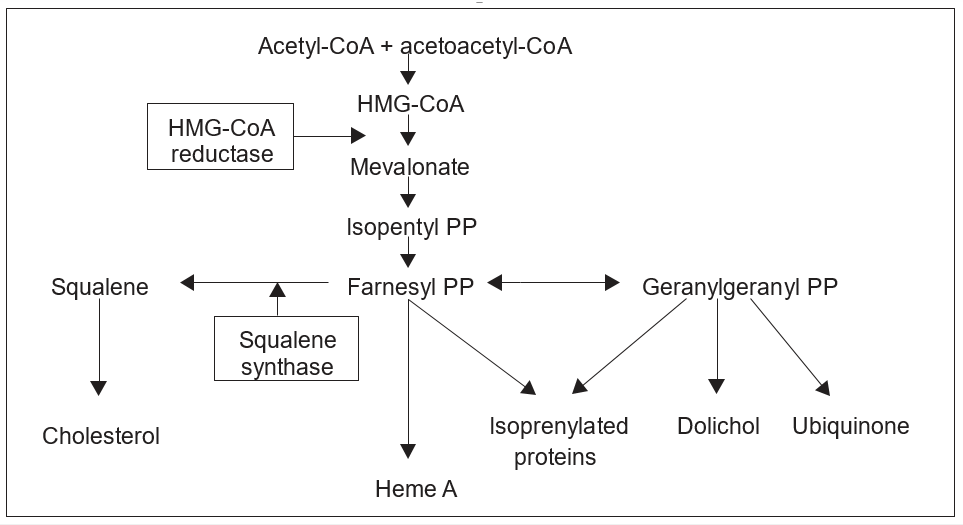Introduction
Statins (HMG-CoA reductase inhibitors) are the mainstay for treating lipid disorders characterized by low-density lipoprotein cholesterol (LDL-C) elevations. Statins have revolutionized the prevention of primary and secondary coronary atherosclerotic disease due to their lipid-lowering properties and other pleiotropic effects that beneficially affect atherosclerotic plaque stability.1 A class of disorders known as myopathies results in damage to the muscle fibers and weakening of the muscles. Myopathies come in several forms and can be brought on by autoimmune diseases, genetics, or specific drugs. Muscle cramps, stiffness, and weakness are common symptoms. Depending on the particular form of myopathy, treatment options may include alternative medication, physical therapy, or lifestyle modifications. Most patients very well tolerate statins; however, 10 -12% develop muscle-related adverse effects. 2
Pathophysiology
There are several potential explanations for statin-induced myopathy, but the precise mechanism is yet unknown. Leading suggestions include depletion of isoprenoids, suppression of ubiquinone or coenzyme Q10 (CoQ10) synthesis, modification or decrease of cholesterol in the sarcolemal membrane, disruption of calcium metabolism, or autoimmune events.
Figure 1
The cholesterol biosynthetic pathway. Statin inhibition of HMG-CoA reductase, the rate-limiting step of cholesterol synthesis, causes a reduction in the production of isoprenoids, most importantly farnesyl PP and geranylgeranyl PP. The reductionof isoprenoids causes a reduction in the production of isoprenylated proteins whose deficiency causes disturbances in cell apoptosis regulation and skeletal muscle cell structure.3, 4, 5, 6, 7

Depletion of isoprenoid
One proposed mechanism of skeletal muscle cell death is statin-induced isoprenoid deficiency. Isoprenoids are lipids by-products of the HMG-CoA reductase pathway.5 Farnesyl pyrophosphate (F-PP) and geranylgeranyl pyrophosphate (GG-PP) are the most important isoprenoids in the HMG-CoA reductase pathway (Figure 1). 8 Protein prenylation is the process by which isoprenoids bind to proteins via either farnesylation or geranylgeranylation. Statins reduce the phrenylation of proteins.6 The reduction of protein prenylation (farnesylation or geranylgeranylation) is thought to increase systolic calcium which activates caspase-3 and leads to cell death. Supporting the role of isoprenoids in statin myopathy is the finding that statin-induced apoptosis in vascular smooth muscle cells is prevented by supplementation with isoprenoids including F-PP and GG-PP.7, 9
Ubiquinone inhibition or CoQ10
Ubiquinone or CoQ10 is a constituent of oxidative phosphorylation and ATP production in the mitochondria.10 Statins inhibit the synthesis of mevalonate, a precursor of CoQ10. Theoretically, statins can cause myopathy by inhibiting the synthesis of CoQ10 in the mitochondria which might compromise the function of the mitochondrial respiratory chain, impair energy production, and ultimately induce myopathy.10
Lower sarcolemmal cholesterol levels
Reduced cholesterol levels cause alterations in myocyte membrane cholesterol.11 Sarcolemal cholesterol deficiency, as a result of the dynamic equilibrium between membrane and plasma lipids, may adversely modify membrane physical properties, such as membrane integrity and fluidity, thus resulting in membrane destabilization. 12 However, two key findings argue against this mechanism. The first is that myotoxicity does not occur in vitro when cholesterol is lowered by inhibiting squalene synthetase in human skeletal myotubules.13 The second finding is that inherited disorders of the distal cholesterol synthetic pathway result in reduced cholesterol levels without associated clinical myopathy.14
Disturbed calcium homeostasis
The regulation of calcium (Ca2+) release and uptake is critical for the normal function of muscle cells.8 L-type calcium channels mediate the initial increase of intracellular calcium. The sarcoplasmic reticulum's ryanodine receptors are opened by this rise in intracellular Calcium, which results in a significant rise in intracellular Calcium that starts muscle contraction. In a study by Mohaupt et al., muscle biopsies from statin myopathy patients revealed elevated expression of ryanodine receptors 3 (RR3). It is unknown whether elevated RR3 causes or contributes to statin myopathy susceptibility.4
Diagnosis
The NLA does not recommend routine measurement of CPK for all patients before starting statin therapy.3 However, serum creatinine kinase (CPK) can be advised to patients who are presenting with muscle toxicity. Normal levels of CPK are 55-170 U/L in male,30-145 U/L in females.
Case Presentation
History of present illness
A 35-year-old male patient came to the hospital with chief complaints of severe muscle cramps at midnight for 3 years on and off symptoms increased since 3 days. These symptoms are developed after the usage of rosuvastatin. He is a known case of hypertension since 5yrs on regular medication cilnidipine, CAD since 3 years on regular medication rosuvastatin and clopidogrel. He came for a regular checkup at cardiology. The doctor advised atorvastatin instead of rosuvastatin.
Systemic Examination
Discussion
Statins continue to be the mainstay of the dyslipidemia treatment regimen and a crucial medication for both primary and secondary cardiovascular disease prevention. Doctors can lower the prevalence of statin myopathy by treating each patient differently. A low-dose statin or a statin substation should be administered to patients who have risk factors for statin myopathy, and the dosage should be gradually increased for patients with myopathy, several strategies have been proposed as an alternative to daily statin therapy. Among them are long-acting statins like atorvastatin.
